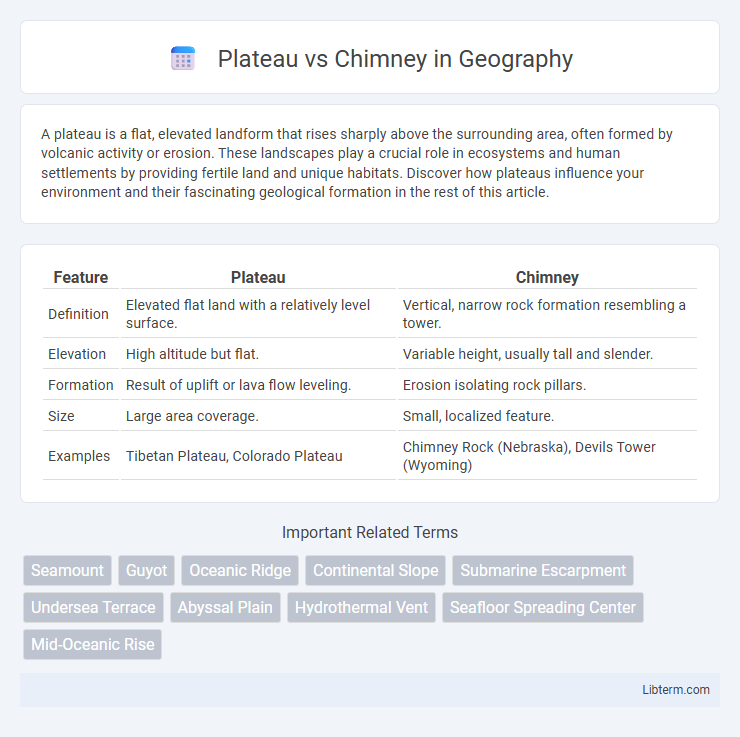A plateau is a flat, elevated landform that rises sharply above the surrounding area, often formed by volcanic activity or erosion. These landscapes play a crucial role in ecosystems and human settlements by providing fertile land and unique habitats. Discover how plateaus influence your environment and their fascinating geological formation in the rest of this article.
Table of Comparison
| Feature | Plateau | Chimney |
|---|---|---|
| Definition | Elevated flat land with a relatively level surface. | Vertical, narrow rock formation resembling a tower. |
| Elevation | High altitude but flat. | Variable height, usually tall and slender. |
| Formation | Result of uplift or lava flow leveling. | Erosion isolating rock pillars. |
| Size | Large area coverage. | Small, localized feature. |
| Examples | Tibetan Plateau, Colorado Plateau | Chimney Rock (Nebraska), Devils Tower (Wyoming) |
Introduction to Plateaus and Chimneys
Plateaus are elevated flat-topped landforms that rise sharply above the surrounding area, formed primarily by tectonic activity or volcanic eruptions, characterized by their extensive, level surface. Chimneys refer to vertical rock formations, often narrow and towering, created through erosion processes that isolate harder rock from surrounding softer material. Understanding the distinct geological processes and structural features of plateaus and chimneys helps explain their contrasting shapes and environmental impact.
Geological Formation of Plateaus
Plateaus are elevated flatlands formed primarily by volcanic activity, tectonic uplift, or erosion-resistant rock layers, resulting in a broad, level surface. In contrast, chimneys are narrow, vertical rock formations often created by differential erosion of sedimentary layers around a harder core. The geological formation of plateaus involves extensive processes such as the uplifting of Earth's crust or the accumulation of lava flows that solidify into expansive, elevated terrains.
Geological Formation of Chimneys
Chimneys form through differential erosion of volcanic rocks or sedimentary layers, where isolated vertical columns remain as softer surrounding materials erode away. This geological process creates steep, narrow towers that stand prominently against the landscape, contrasting with the broad, flat surfaces characteristic of plateaus. The unique formation of chimneys often involves tectonic activity and weathering, resulting in distinct, pillar-like structures.
Distinctive Features of Plateaus
Plateaus are elevated flat-topped landforms with steep sides, formed primarily through tectonic uplift or volcanic activity, distinguishing them from chimneys, which are narrow vertical rock formations created by erosion. Plateaus often cover extensive areas and support diverse ecosystems or human settlements, whereas chimneys are isolated columns of rock typically found in arid or mountainous regions. The broad, level surface of plateaus makes them significant for agriculture and habitation, contrasting sharply with the slender, towering structure of chimneys.
Distinctive Features of Chimneys
Chimneys are vertical, narrow geological formations characterized by steep, often near-vertical walls and a significant height relative to their base, distinguishing them sharply from plateaus, which are extensive, flat elevated landforms with broad, horizontal surfaces. The distinctive features of chimneys include their column-like shape, erosion resistance due to harder rock cores, and formation through differential erosion processes that isolate them from surrounding softer rock layers. Unlike plateaus, chimneys serve as prominent, isolated landmarks often associated with dramatic landscapes such as badlands or canyon regions.
Plateaus vs Chimneys: Structural Differences
Plateaus are elevated flat-topped landforms with steep sides formed primarily by tectonic uplift or volcanic activity, featuring wide, expansive surfaces. Chimneys, in geological contexts, often refer to narrow, vertical rock formations such as volcanic or sedimentary spires shaped by erosion processes that isolate these towering structures. The key structural difference lies in the plateau's broad, horizontal expanse contrasted with the chimney's slender, vertical prominence.
Ecological Significance of Plateaus
Plateaus serve as vital ecological zones due to their unique elevation and relatively flat terrain, fostering distinct plant and animal communities adapted to cooler temperatures and specific soil conditions. These elevated landscapes often support endemic species and act as crucial water catchment areas, influencing regional hydrology and biodiversity. In contrast, chimneys, primarily vertical rock formations, offer limited ecological niches and contribute less to broader ecosystem services compared to the expansive habitats provided by plateaus.
Ecological Significance of Chimneys
Chimneys, as geological formations, create unique microhabitats that support specialized flora and fauna, contributing to biodiversity hotspots. Their vertical structures influence local climate conditions by providing shade and moisture retention, which helps sustain various ecological niches. This environmental complexity contrasts with plateaus, which typically support more uniform ecosystems due to their flat, expansive surfaces.
Famous Plateaus and Chimneys Around the World
Famous plateaus such as the Tibetan Plateau, known as the "Roof of the World," and the Colorado Plateau, renowned for its vibrant rock formations, showcase vast elevated flatlands formed by tectonic uplift or volcanic activity. Iconic chimneys like the Badlands Hoodoos in South Dakota and the Fairy Chimneys of Cappadocia, Turkey, feature tall, thin spires sculpted by erosion, often composed of sedimentary rock or volcanic tuff. These geological formations highlight the diverse processes that shape Earth's surface, attracting geologists and tourists worldwide.
Conclusion: Comparing Plateaus and Chimneys
Plateaus and chimneys represent distinct geological formations with unique structural characteristics; plateaus are elevated flat-topped areas formed by tectonic uplift or volcanic activity, while chimneys are vertical, narrow rock formations created primarily through erosional processes. The comparison highlights that plateaus cover extensive regions with relatively stable, horizontal surfaces, whereas chimneys are isolated pillars often found in desert or canyon environments. Understanding these differences is crucial for geological mapping, natural resource exploration, and environmental management.
Plateau Infographic

 libterm.com
libterm.com